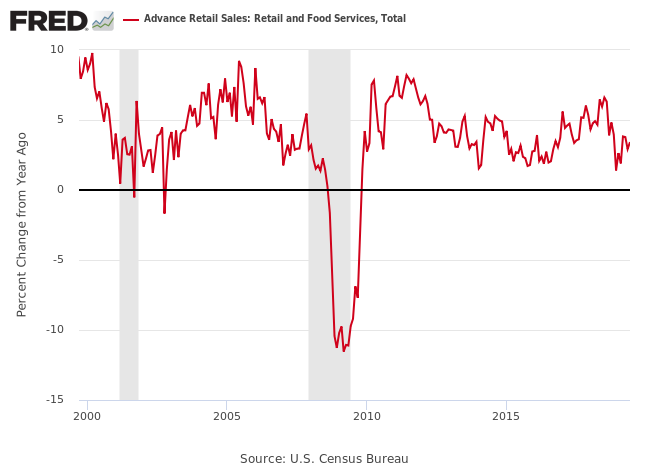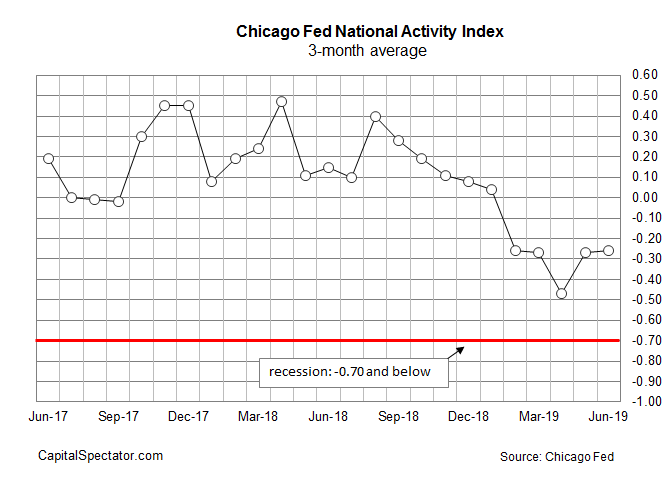This year’s slowdown in US economic growth has been accompanied by stronger headwinds in manufacturing and housing. History suggests these are clear signs that recession risk is elevated and it’s merely a matter of time before the business cycle succumbs. But optimists say that consumer spending, supported by what’s expected to be a new round of rate cuts by the Federal Reserve, will save the day and keep growth alive. The next several weeks of data releases (starting with next week’s employment report) may tell us which outlook is correct.
Let’s take a closer look at the numbers for some perspective on what may be coming, starting with manufacturing. Survey data for July shows that growth has come to a standstill. The IHS Markit Flash US Manufacturing Purchasing Managers Index edged down to 50, a neutral reading that’s the lowest in a decade and reflects a sector on the cusp of recession if it slips below that mark. IHS Markit, which publishes the PMI data, notes:
The negative influences on the headline PMI were lower production volumes, a fall in employment and reduced stocks of purchases. Production levels dropped only slightly, but the rate of decline was the greatest since August 2009. Moreover, the marginal decrease in staffing levels ended a six-year period of sustained job creation across the manufacturing sector.
The housing sector is having troubles of its own. The long-running trend in existing sales for homes remains negative, with red ink persisting for the year-over-year change for the 16th straight month in June. New home sales offered a bit of upbeat news yesterday, but the chief economist at RDQ Economics, John Ryding, says “there is no evidence here to change the narrative that the response of the housing market to lower mortgage rates has been underwhelming.”
Construction activity in the housing sector also reflects a conspicuous weakening in recent history. The one-year changes for housing starts and building permits indicate a clear downshift over the past year or so.

The main source of optimism that the US expansion will endure: consumer spending. Consider the one-year trend for retail sales. For June, spending ticked up to a modest 3.4% pace. That’s a middling gain compared with recent history, although it’s up from December’s stall-speed 1.4% advance, which suggests that it’s premature to pull the plug on the notion that Main Street will continue to support economic momentum for the near term.

The fourth straight month of gains for retail spending in June prompted one economist to quip that “US consumers continued to do what they do best, i.e., spend” (Richard Moody, chief economist at Regions Financial (NYSE:RF).
Reflecting on the second-quarter GDP report that’s due tomorrow (July 26), analysts at the National Bank of Canada advised last week that “strong [US] household demand should help compensate for expected weakness in manufacturing and trade in the quarter and help GDP grow at a pace close to 1.5% annualized.”
In fact, the crowd is looking for a slightly better result in Q2 activity. Econoday.com’s consensus point forecast calls for GDP growth to rise 1.9% in the government’s preliminary Q2 report that’s scheduled for Friday. That’s well below Q1’s strong 3.1% increase, but if the forecast is accurate the data will offer a degree of support for thinking that the US economy can avoid a recession in the near term. By contrast, a significant downside surprise in the GDP release would reshuffle expectations.
For now, there’s still no sign that an NBER-defined contraction has started or is imminent, as detailed in last week’s business cycle profile. But slower growth leaves the economy vulnerable to future shocks.
The bottom line: the next round of data could tell us if recession risk has risen to a critical level. The rear-view mirror suggests otherwise, based on numbers published to date.
The three-month average of the Chicago Fed’s National Activity Index for June, for instance, continues to indicate below-trend growth, but at a pace that’s still comfortably above the tipping point that indicates recession.

The mystery, as always, is the near-term future. On that front, next week’s data will be revealing. In particular, the employment numbers for July will offer valuable insight on the third quarter’s kickoff. Recent history, however, tells us to be wary. The one-year trend for private employment has been weakening this year, slipping to a 1.7% increase in June–the lowest in a year-and-a-half. If this gives way in July, the outlook will darken.

Optimists are quick to note that jobless claims (a leading indicator for the labor market and the economy) remain close to a 50-year low, which implies that the labor market will continue to expand at a healthy pace in the upcoming July report. “Claims remain low, consistent with a still-healthy labor market,” says Jim O’Sullivan, chief US economist of High Frequency Economics.
The burning question: Will next week’s employment report agree?
